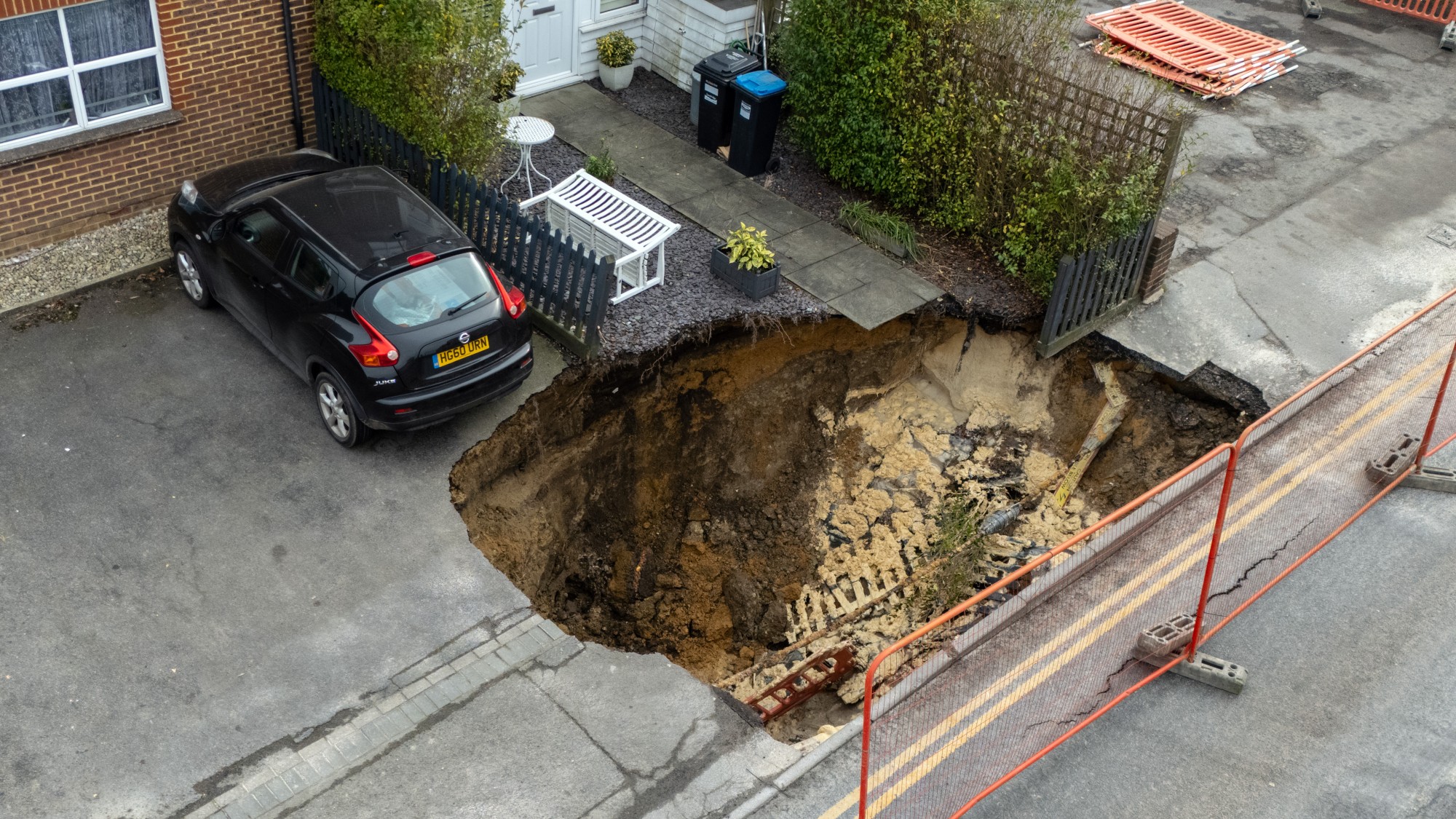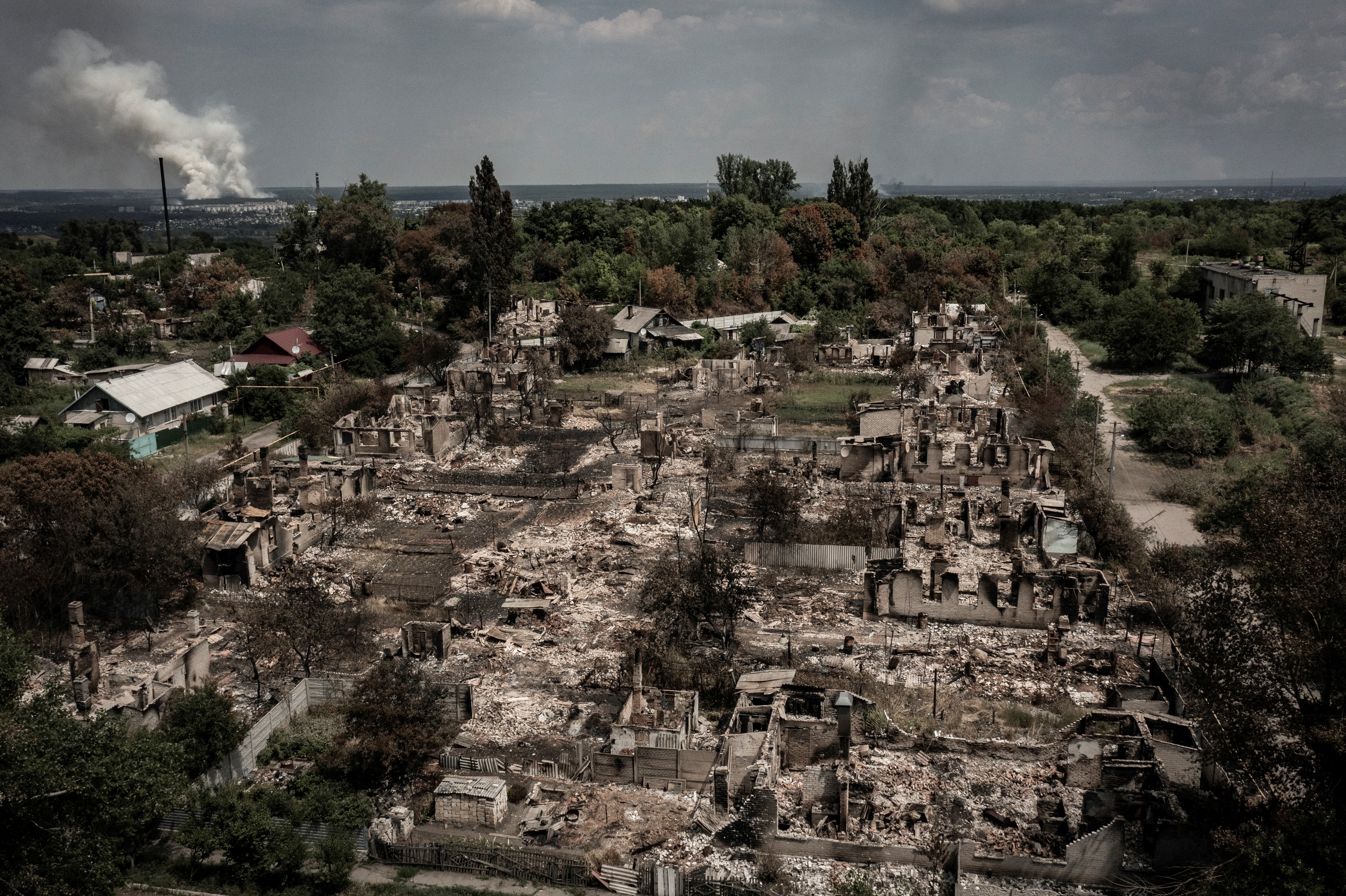The UK's sudden sinkhole struggles
Villagers flee homes after 65ft-long pit opens up in Surrey, swallowing large part of street

Residents have been evacuated and entire streets closed off after two large sinkholes appeared in the Surrey village of Godstone this week.
The first hole opened up on Monday night and engulfed a garden as it reached 65ft in length. It wasn’t until Thursday morning that officials declared it had stopped growing.
Noosh Miri, who had to leave her home at 11.30pm with her husband and family, told BBC News: "We got a violent knocking on the door. As I opened the door, it sounded like I was in a waterfall because the sinkhole was right in front of my doorstep."
The Week
Escape your echo chamber. Get the facts behind the news, plus analysis from multiple perspectives.

Sign up for The Week's Free Newsletters
From our morning news briefing to a weekly Good News Newsletter, get the best of The Week delivered directly to your inbox.
From our morning news briefing to a weekly Good News Newsletter, get the best of The Week delivered directly to your inbox.
The second hole appeared the following day, swallowing up a "large chunk of the street" and leaving a car "teetering" on its edge, reported the Daily Mail.
Surrey County Council declared a major incident and advised people to avoid the area while repairs are carried out. It is believed it will take several months for the work to be completed, and it is not known when the evacuated families will be able to return.
Thankfully, there were no casualties, unlike the situation when a sinkhole of 131ft in diameter opened up in Japan last month. The hole swallowed a truck in Yashio city, near Tokyo, trapping its 74-year-old driver as sand and mud filled the cab. Rescue efforts had to be suspended after fears of further cave-ins, and a body was found last week.
Sinkholes have been reported across the world, causing problems for local communities from Greenwich to Guatemala. They have swallowed cars, ravaged homes and even ruined football pitches – a fundraiser was launched for AFC Wimbledon last year after a hole appeared in the pitch at the team's Cherry Red Records Stadium.
A free daily email with the biggest news stories of the day – and the best features from TheWeek.com
They've also been found throughout history, but why do they happen and are we making them worse?
Why do sinkholes happen?
There are various types of sinkholes – or "dolines", as they're also called. Some are caused by a naturally occurring phenomenon when, over thousands of years, water gradually dissolves soluble rock, forming a cavity under the ground. Loose sedimentary rock from nearer the surface level gradually falls into the cavity, until the surface is unable to sustain itself any longer and collapses.
The process is similar to the motion of an egg timer, said geologist Dr Anthony Cooper of the British Geological Society. Periods of persistent heavy rain or flooding are most likely to expose these holes, but, conversely, sudden drainage of groundwater can also cause them.
"A water-filled cavity beneath a bridge of material will actually support that bridge to a certain degree," Dr Cooper told The Guardian. "If you then pump a lot of water out, all of a sudden that material, which is water-saturated and heavier, suddenly collapses in."
Human activity causes another type of sinkhole, called a crown hole, with abandoned mines and underground sewage works at particular risk of collapse. Disused clay pits were blamed for creating fissures in the ground that led to a sinkhole in St Albans in 2015, reported the BBC.
Sinkholes in the UK are rarely more than a few dozen feet deep, dwarfed by the likes of the Red Lake in Croatia – which, at 1,740ft, is Europe's deepest sinkhole. The largest sinkhole in the world is the 2,172ft deep Xiaozhai Tiankeng in China.
Some parts of Britain are more vulnerable than others, as the likelihood of a sinkhole forming depends on how soluble the underlying rock is. The chalk landscape of the southeast of England makes the area "fairly susceptible", Dr Cooper told The Telegraph, while "from the south up to Norwich, that whole area is susceptible to both natural sinkholes and those caused by mining."
Are we making things worse?
Although the appearance of sinkholes is closely linked to rainfall, humans can exacerbate the process. Water extraction, for whatever reason, is often to blame, reported The Guardian's Karl Mathiesen. "Anything that has the potential to divert water into weak points beneath the earth will accelerate the creation of the pits into which houses, cars and unfortunately people sometimes fall," he said.
But Mathiesen also pointed out that the timescale for many of these events is thousands of years, meaning that most sinkholes began forming long before humans started interfering. "These are primarily natural phenomena, which humans can occasionally influence," he concluded.
Human activity could also be behind the Godstone hole, reported the BBC. Andrew Farrant, of the British Geological Survey, theorised that a burst water main could have caused a sudden influx of water into the area's sandstone rock, "flushing" it out of the way.
Are sinkholes becoming more common?
It's true that more major sinkholes are appearing around the UK. Indeed, it can seem that there's some kind of geological uprising taking place. In the past few years, they have developed in London, St Albans, Buckinghamshire and Ripon. In early 2014, scientists recorded a five-fold increase in the number occurring over a particularly rainy winter – and the evidence suggests there are more to come.
Ongoing climate change raises the likelihood of extreme weather, meaning the torrential rain and flooding conditions which often lead to the exposure of sinkholes are likely to become increasingly common.
But the good news is that the average person is still extremely unlikely to be swallowed by one. Despite "at least" 32,000 natural sinkholes scattered around the country in 2014, according to The Guardian, they have not been responsible for a single death.
Is it possible to predict where and when a sinkhole will occur?
Wet weather leading to saturated ground is the primary catalyst for the appearance of natural sinkholes in the UK.
Because they are usually caused by the erosion of bedrock, sinkholes form more easily in areas that stand on chalk, gypsum or salt rock, which dissolve quicker than other types of ground. As well as making the southeast more prone to be hit, this also makes the Isle of Wight and parts of Yorkshire more vulnerable.
Surveying can establish whether a property is built over any man-made features, such as a disused mine or tunnel, that increase the risk of a hole occurring. However, it is harder to predict where naturally occurring sinkholes will appear as it would be impractical to uncover and monitor all the fissures and cavities that might eventually form one.
-
 US citizens are carrying passports amid ICE fears
US citizens are carrying passports amid ICE fearsThe Explainer ‘You do what you have to do to avoid problems,’ one person told The Guardian
-
 All roads to Ukraine-Russia peace run through Donetsk
All roads to Ukraine-Russia peace run through DonetskIN THE SPOTLIGHT Volodymyr Zelenskyy is floating a major concession on one of the thorniest issues in the complex negotiations between Ukraine and Russia
-
 Why is Trump killing off clean energy?
Why is Trump killing off clean energy?Today's Big Question The president halts offshore wind farm construction